.jpg.webp)
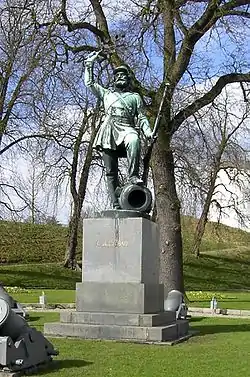
A Tomb of the Unknown Soldier or Tomb of the Unknown Warrior is a monument dedicated to the services of an unknown soldier and to the common memories of all soldiers killed in war. Such tombs are located in many nations and are usually high-profile national monuments. Throughout history, many soldiers have died in war with their remains being unidentified. Following World War I, a movement arose to commemorate these soldiers with a single tomb, containing the body of one such unidentified soldier.
History
A shrine in Jinju, Korea, which commemorated those who died in defense of Korea during the Imjin War in 1592, has been described as the first Tomb of the Unknown Soldier. It is, however, more inclusive, in that it is a memorial to all who died in defense of the city against the forces of Toyotomi Hideyoshi, civilian as well as soldier.[1] Beginning in 1593, when the Ministry of Rites received permission to perform a sacrifice for all who died in the battle, not only the identifiable bodies, the state offered sacrifices for the dead twice a year in spring and autumn until 1908, when the practice was ended by royal edict.[2]
The first known monument of an unknown soldier in Europe is Landsoldaten ("The Valiant Private Soldier")[3] (1849), from the First Schleswig War, in Fredericia, Denmark.
France and the United Kingdom
During the First World War, the British and French armies who were allies during the war jointly decided to bury soldiers themselves. In the UK, under the Imperial War Graves Commission (now Commonwealth War Graves Commission), the Reverend David Railton had seen a grave marked by a rough cross while serving in the British Army as a chaplain on the Western Front, which bore the pencil-written legend "An Unknown British Soldier".[4]
He suggested (together with the French in their own country) the creation at a national level of a symbolic funeral and burial of an "Unknown Warrior", proposing that the grave should in the UK include a national monument in the form of what is usually, but not in this particular case, a headstone. The idea received the support of the Dean of Westminster, Prime Minister David Lloyd George, and later from King George V, responding to a wave of public support.[4] At the same time, a similar concern grew in France. In November 1916, a local officer of Le Souvenir français proposed the idea of burying "an unknown soldier" in the Panthéon. A formal bill was presented in Parliament in November 1918. The decision was voted into law in September 1919.[5]
The United Kingdom and France conducted services connected with their 'monumental' graves (as presumably newly conceived, and in any case approved, by their respective armies) on Armistice Day 1920 (the burial itself taking place later in January of the following year in France). In the UK, the Tomb of the Unknown Warrior was created at Westminster Abbey, while in France La tombe du soldat inconnu was placed in the Arc de Triomphe.
Other countries
The idea of a symbolic Tomb of the Unknown Soldier then spread to other countries. In 1921, the United States unveiled its own Tomb of the Unknown Soldier, Portugal its Túmulo do Soldado Desconhecido, and Italy its Tomba del Milite Ignoto. Other nations have followed the practice and created their own tombs.
In Chile and Ukraine, the second 'unknown tombs' were unveiled to commemorate The Unknown Sailor.
In Serbia, soldiers of World War I are commemorated by the Monument to the Unknown Hero on the mountain of Avala.
In the Philippines, the Tomb of the Unknown Soldier at the Libingan ng mga Bayani ("Cemetery of the Heroes") is the cemetery's most prominent structure.
Symbolism
The Tombs of the Unknown Soldiers typically contain the remains of a soldier who is unidentified (or "known but to God" as the stone is sometimes inscribed).[6] These remains are considered impossible to identify, and so serve as a symbol for all of a country's unknown dead wherever they fell in the war being remembered. The anonymity of the entombed soldier is the key symbolism of the monument; it could be the tomb of anyone who fell in service of the nation, and therefore serves as a monument symbolizing all of the sacrifices.
Identification
Many soldiers have been identified by DNA analysis. The first one to be analyzed was an airman from the Vietnam War.[7]
Examples
Tombs of the Unknown Soldiers from around the world and various wars include the following:
| Country | Momument | Location | Image | Description |
|---|---|---|---|---|
| Statue of the Unknown Soldier | Tirana | _(BLGU_Spring_School_2013)_02.JPG.webp) |
||
| Metropolitan Cathedral | Buenos Aires |  |
Tomb of the Unknown Soldier of the Argentine War of Independence | |
| National Flag Memorial | Rosario |  |
Tomb of the Unknown Soldier | |
| Tomb of the Unknown Soldier at Victory Park | Yerevan |  |
Tomb of the Unknown Soldier; commemorates the victory of the Soviet Union in World War II | |
| Australian War Memorial | Canberra |  |
The tomb of the Unknown Australian Soldier at the Australian War Memorial in Canberra. | |
| Outer Palace Gate at the Heldenplatz | Vienna | _IMG_0413.jpg.webp) |
Within the 1818 neo-classical gateway to the Hofburg, the former Imperial Palace. | |
| Jatiyo Smriti Soudho | Savar Upazila |  |
Jatiyo Sriti Shoudhor National Martyrs' Memorial is the national monument of Bangladesh for those who gave their lives in the Bangladesh Liberation War of 1971, many of whom were buried in mass graves in that park. The monument is located in Savar, about 35 km north-west of the capital, Dhaka. It was designed by Syed Mainul Hossain. | |
| Shikha Onirban or 'Eternal Flame' | Dhaka | _-_panoramio.jpg.webp) |
Shikha Onirban was built to commemorate the valour and the sacrifices of Bangladesh Armed Forces Soldiers died in the Bangladesh Liberation War in 1971. | |
| Congress Column | Brussels |  |
The Tomb of the Unknown Soldier at the base of the location. | |
| Monumento al Soldado Desconocido | La Paz | The Tomb of the Unknown Soldier, center piece of the location. | ||
| Monument to the dead of World War II, Flamengo Park | Rio de Janeiro. |  |
The Tomb of the Unknown Soldier on the monument's platform. | |
| Brazilian Monument and Tomb of the Unknown Soldier of World War II | Pistoia, Italy. |  |
Votive Tomb of the Unknown Soldier, with monument pavilion. | |
| Monument to the Unknown Soldier | Sofia |  |
||
| Monument to the Unknown Soldier | Haskovo.[8] | |||
| Tomb of the Unknown Soldier at the National War Memorial | Ottawa |  |
The tomb is located next to the National War Memorial in Confederation Square in Ottawa. It contains the remains of a Canadian soldier from World War I, who was buried near Vimy Ridge.[9] | |
| General Manuel Baquedano Square | Santiago |  |
Contains the remains of a soldier who died in 1881 during the War of the Pacific. | |
| Plaza de la Ciudadanía (Citizenship Square), | Santiago | 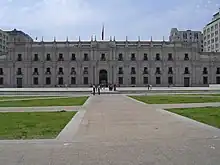 |
Contains the remains of a soldier found in Perú. Died in 1881 during the War of the Pacific. | |
| Cripta del Morro de Arica (Morro de Arica Crypt), | Arica | Contains the remains of a soldier found in 1998. Died during the War of the Pacific. | ||
| Unknown Sailor Monument | A monument built in honor to the sailors that fought and died in the Battle of Iquique, a naval battle off the coast of Chile. | |||
| Monument to the People's Heroes | 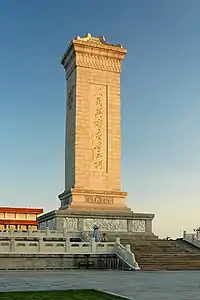 |
A moment built in honor to the Chinese heroes died between 1840s (the First Opium War) and 1949 (founding of the People's Republic of China), who have given their lives in the many struggles to resist the enemy, domestic and foreign, to strive for the independence of the nation and the freedom of the people. | ||
| Plaza y Monumento de los Caídos on Centro Administrativo Nacional | Bogotá |  |
||
| Monument to Croatian unknown soldier | Osijek | 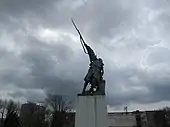 |
||
| National Monument on Vítkov Hill | Prague | 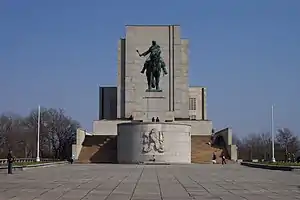 |
Contains remains of an unknown Czechoslovak soldier fallen at the Battle of Zborov as well as an unknown Czechoslovak soldier fallen at the Battle of Dukla, a part of a larger memorial to all Czechoslovak soldiers. | |
| Flag Square of Santo Domingo |  |
The Arc of the Square contains the tomb of an unknown fallen soldier who participated in the Dominican War of Independence. | ||
| Unknown Soldier Memorial | Cairo | 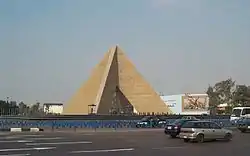 |
Also includes the tomb of President Anwar Sadat. | |
| Alexandria Naval Unknown Soldier Memorial | .jpg.webp) |
|||
| Defence Forces Cemetery | Tallinn |  |
||
| Hietaniemi cemetery | Helsinki | %252C_Helsinki%252C_Finland.jpg.webp) |
In the centre of the military cemetery are the tombs of the unknown soldier and Marshal Carl Gustaf Emil Mannerheim. | |
| Tomb of the Unknown Soldier beneath the Arc de Triomphe | Paris |  |
||
| Tomb of the Unknown Soldier behind Arch 22 | Banjul | 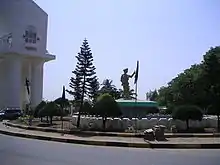 |
||
| Tomb of the Unknown Soldier, Tbilisi | 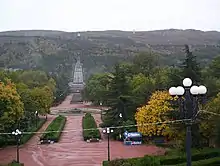 |
Located in Vake Park | ||
| Unter den Linden | Berlin |  |
Within a 19th-century guardhouse, the Neue Wache. | |
| Tomb of the Unknown Soldier on Syntagma Square | Athens |  |
| |
| Heroes' Square | Budapest |  |
The Memorial Stone of Heroes (Hősök emlékköve) is a low stone cenotaph surrounded by an ornamental iron chain. The cenotaph is dedicated "To the memory of the heroes who gave their lives for the freedom of our people and our national independence." | |
| Amar Jawan Jyoti | New Delhi |  |
Burning in a shrine under the arch of India Gate since 1971 is the Amar Jawan Jyoti (the flame of the immortal soldier) which marks the Tomb of the Unknown Soldier. The shrine itself is a black marble cenotaph with a rifle placed on its barrel, crested by a soldier's helmet. Each face of the cenotaph has inscribed in gold the words "Amar Jawan" (Immortal Warrior) in Hindi (Devanagri script). The Prime Minister of India pays homage to the country's fallen soldiers along with the Chiefs of Staff of each arm of the Armed Forces on each Republic Day of India. | |
| The Pandu Memorial Cemetery | Bandung |  |
The Field of Honor is a memorial to the unknown soldier. There is also the Tomb of the Unknown (Dutch) Sailor in Kembang Kuning war cemetery in Surabaya.[12] | |
| Chizar | Tehran |  |
In Iran, unknown soldiers are buried in public places. Chizar is the largest of all. | |
| Behesht Zahra | Tehran |  |
||
| Unknown Soldier Park | Tehran |  |
||
| The Monument to the Unknown Soldier, in Grand Festivities Square | Zawra Park, Baghdad | 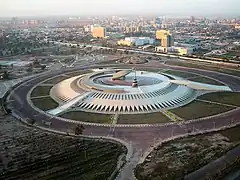 |
Three monuments in Zawra Park commemorate Iraq's fallen soldiers; The Monument to the Unknown Soldier (pictured), the Victory Arch (completed in 1989) and the Al-Shaheed Monument (also known as the Martyrs' Monument, completed in 1983). The Monument to the Unknown Soldier was constructed between 1979 and 1982, and replaced an earlier Unknown Soldier's Monument built in 1959 in a different location, but dismantled when the current monument was inaugurated. | |
| National Memorial Hall For Israel's Fallen, Mount Herzl | Jerusalem |  |
The Eternal Flame Monument to Unknown Soldiers. | |
| Piazza Venezia | Rome | 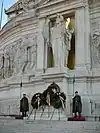 |
The Tomb of the Milite Ignoto in the Altare della Patria (Vittoriano). | |
| Chidorigafuchi National Cemetery | Tokyo | 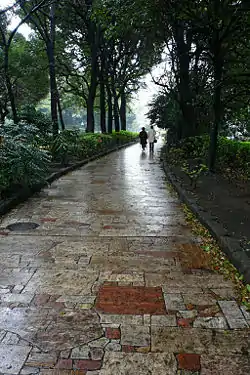 |
||
| Ryozen Kannon | Kyoto |  |
||
| Tomb of the Unknown Soldier of the World | Ogose, Saitama | |||
| Dai Heiwa Kinen Tō | Tondabayashi, Osaka |  |
||
| Tomb of the Unknown Soldier | Amman | Source: | ||
| Tomb of the Unknown Soldier in Lebanon | Beirut, Mathaf | The Tomb of the Unknown Soldier in Lebanon represents the forming and independence of the Lebanese Armed Forces from the French Army in 1943.[13] The tomb also commemorates soldiers of the Legion of Orient[14] and the Army of the Levant during the French Mandate of Lebanon from 1920 to 1943.[13] The cenotaph in the middle includes a Cedrus libani tree surrounded by a laurel; the main symbol of Roman Legions. Around the cedar tree and laurel reads in Arabic : "Glory and Immortality for our Martyred Heroes". Behind the cenotaph are original Roman Columns. | ||
| Vienybės Square | Kaunas |  |
Tomb of Nežinomas kareivis, with remains of soldier who died in fights against Bolsheviks in 1919. | |
| National Monument | Kuala Lumpur | 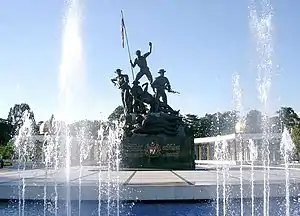 |
Completed in 1966 to commemorate fallen combatants against Japanese occupation of pre-independence Malaysia in World War II and the Malayan National Liberation Army during the Malayan Emergency. Also includes a pre-independence cenotaph, which was shifted from its original location closer to the old town of Kuala Lumpur, commemorating the war dead of World War I, World War II and the Malayan Emergency. | |
| Monument of Unknown Soldier, Siege Bell War Memorial | Valletta |  |
||
| Tomb of the Unknown Soldier | Curepipe | |||
| Heroes' Acre | Windhoek | The Tomb of the Unknown Soldier contains soil from Cassinga and Oshatotwa from the Namibian War of Independence. | ||
| Tomb of the Unknown Warrior, National War Memorial | Wellington |  |
||
| Tomb of the Unknown Soldier | Eagle Square, Abuja. | 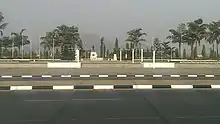 |
Statue of the Unknown Soldier, at the Eagle Square, Abuja, formerly located in Idumota, Lagos as Soldier Idumota, the tomb was relocated to Abuja. | |
| Plaza Bolivar | Lima | 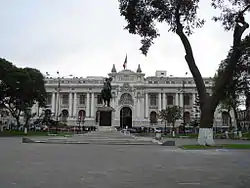 |
Contains the remains of a soldier who died in 1881 during the War of the Pacific. | |
| Libingan ng mga Bayani | Taguig City |  |
Contains the remains of Filipino soldiers who have joined the military and served on the Philippine Revolution, Philippine–American War and World War II. | |
| Tomb of the Unknown Soldier, Marshall Józef Piłsudski Square | Warsaw |  |
Constructed as the arcade of Saxon Palace, which was destroyed by the Germans in 1944. Contains the remains of a soldier who died between 1918 and 1920. | |
| Tomb of the Unknown Soldier | Batalha Monastery | .jpg.webp) |
Housed within the Chapter House of Batalha Monastery. It contains the remains of two unknown World War I soldiers; one from the battlefields of Flanders, and one from the African theater, who were interred on 6 April 1921.[15] | |
| Tomb of the Unknown Soldier, Carol Park | Bucharest |  |
||
| Tomb of the Unknown Soldier, Alexander Garden | Moscow |  |
||
| Monument to the Unknown Hero on Mt. Avala | Belgrade | 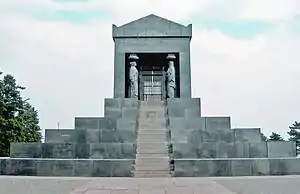 |
Memorial was built on the place where an unknown Serbian World War I soldier was buried. | |
| Monument to the Unknown French Soldier, French Revolution Square | Ljubljana |  |
||
| Tomb of the Unknown Soldier | Mogadishu |  |
A monument erected in honour of fallen Somali combatants, also known as Daljirka Dahsoon. | |
| Monumento a los Caídos por España, Plaza de la Lealtad | Madrid | _01.jpg.webp) |
Popularly known as the Obelisco ("Obelisk"), it is built on the same place where General Joachim Murat ordered the execution of numerous Spaniards after the Dos de Mayo Uprising of 1808. Originally inaugurated on 2 May 1840, it was re-inaugurated on 22 November 1985, by Juan Carlos I of Spain as a remembrance to fallen Spaniards. An eternal flame fuelled by gas has been constantly burning on the front of the monument. | |
| Memorial de Guerra, Fossar de les Moreres | Barcelona | 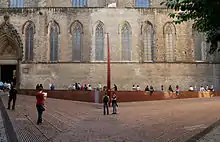 |
Situated next to the Santa Maria del Mar church, the memorial stands in the center of a square that was used as a mass grave after the fall of Barcelona in the War of the Spanish Succession in 1714. It has a special significance to catalan nationalism as a symbol of those who fought against the Bourbons to retain Catalonia's laws and freedoms. Today, an eternal flame burns atop a metal structure with inscriptions that remember the unknown soldiers who died defending the city and the country. | |
| Tomb of the Unknown Soldier | Damascus |  |
||
| Monument to the Unknown Taiwanese Soldiers, War and Peace Memorial Park | Kaohsiung | |||
| Çanakkale Martyrs' Memorial | Gallipoli |  |
Erected for the unknown soldiers of the Çanakkale Front during the Battle of Gallipoli during World War I. Opened on 20 August 1960. | |
| Tomb of the Unknown Soldier, Park of Eternal Glory | Kyiv | 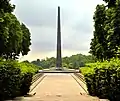 |
||
| Monument to the Unknown Sailor, Shevchenko Park | Odesa |  |
||
| Tomb of the Unknown Warrior, Westminster Abbey | London |  |
First example of the Tomb of the Unknown Soldier. | |
| Tomb of the Unknown Soldier, Arlington National Cemetery | Arlington, Virginia |  |
[16] | |
| Tomb of the Unknown Revolutionary War Soldier, Washington Square | Philadelphia |  |
||
| Tomb of the Unknown Soldier of the American Revolution | ||||
| Civil War Unknowns Monument, Arlington National Cemetery | Arlington County, Virginia |  |
Contains the remains of 2,111 unknown Union and Confederate soldiers from Civil War battlefields. | |
| Tomb of the Unknown Confederate Soldier at Beauvoir | Biloxi, Mississippi | 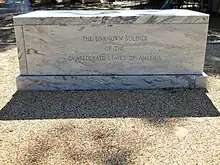 |
||
| El Entrevero at Plaza Fabini | Montevideo |  |
Inaugurated in 1967 in honor of the Oriental Revolution its inscription reads in Spanish: "The Fatherland pays tribute to its anonymous heroes, who in the solitude of the fields lost their lives in the sacrifice for their ideals". | |
| Tomb of the Unknown Soldier on Mustaqillik Maydoni | Tashkent | 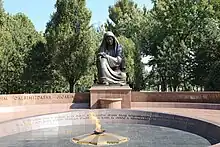 |
Created in 1975, the Tomb of the Unknown Soldier is dedicated to the Uzbek soldiers who served in the Red Army during World War II. | |
| Tomb of the Unknown Soldier on Carabobo Field, Valencia | Carabobo | 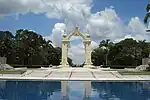 |
Contains the remains of a Venezuelan soldier who died in 1824 during the Battle of Ayacucho. | |
| Monument of Heroic Martyrs | Hanoi | .JPG.webp) |
Dedicated to fallen soldiers of the Vietnam War. | |
| Statue of the Unknown Soldier at the National Heroes Acre | Harare | 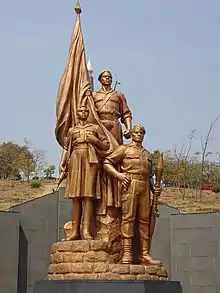 |
See also
References
- ↑ Craig, J. Marshall (2020). China, Korea, and Japan at war, 1592–1598 : eyewitness accounts. Abingdon, Oxon. p. 173. ISBN 978-0-429-46910-7. OCLC 1151661653.
{{cite book}}: CS1 maint: location missing publisher (link) - ↑ Haboush, JaHyun Kim (2016). The great East Asian war and the birth of the Korean nation. William Joseph Haboush, Jisoo M. Kim. New York. pp. 137–138. ISBN 978-0-231-54098-8. OCLC 944243650.
{{cite book}}: CS1 maint: location missing publisher (link) - ↑ "The Valiant Private Soldier | Fredericia Museum". www.fredericiahistorie.dk. Retrieved 2021-05-11.
- 1 2 Henry Allingham, Dennis Goodwin (2011). Kitchener's Last Volunteer: The Life of Henry Allingham, the Oldest Surviving Veteran of the Great War. p. 132. Random House, 1976
- ↑ (in French) Jean-Yves Le Naour, Le soldat inconnu : la guerre, la mort, la mémoire, Gallimard, 2008, p. 20
- ↑ Kwon, Heonik (2008). Ghosts of War in Vietnam. Cambridge University Press. p. 46. ISBN 978-0-521-88061-9.
- ↑ Wagner, Sarah (2013). "The making and unmaking of an unknown soldier". Social Studies of Science. 43 (5): 631–656. doi:10.1177/0306312713484646. JSTOR 43284199. S2CID 145373888.
- ↑ "The Unknown Soldier Memorial in Haskovo".
- ↑ "National War Memorial". ottawakiosk.com. Archived from the original on 18 May 2009. Retrieved 21 April 2015.
- ↑ Thucydides (1942). "2.34.3". Historiae in two volumes. Oxford: Oxford University Press. Available online at the Perseus Project.
- ↑ Thucydides (1942). "2.43.3". Historiae in two volumes. Oxford: Oxford University Press. Available online at the Perseus Project.
- ↑ "Netherlands war cemeteries in Indonesia", Netherlands War Graves Foundation
- 1 2 "Lebanese Ground Forces". GlobalSecurity.org. Retrieved 8 December 2008.
- ↑ "LAF History". Lebanese Armed Forces. Archived from the original on 1 May 2009. Retrieved 19 May 2009.
- ↑ "Batalha Portugal: The Complete Guide to Visiting Batalha". We Travel Portugal. 2022-10-23. Retrieved 2023-11-05.
- ↑ "Tomb of the Unknown Soldier". Arlington National Cemetery. Retrieved November 11, 2018.
External links
- Copernicus Organization, World Veterans Federation, "Tombs of the Unknown Soldier in Central and Eastern Europe" by Prof. Michał Chilczuk, Chairman, Working Group on Central and Eastern Europe, SCEA
- "Tomb of the Unknown Soldier Around The World (History)". Vivaboo.com. Archived from the original on 2011-12-09.
